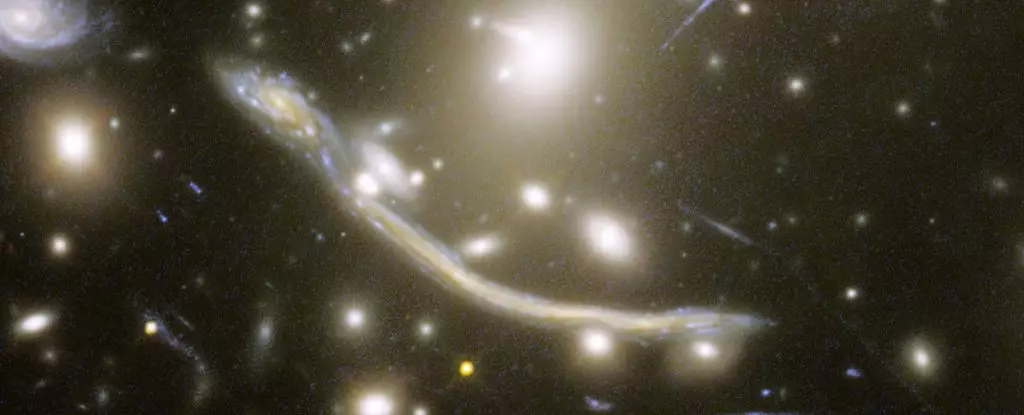The depths of the cosmos hold secrets about our universe’s infancy, with photons that have traveled across billions of light-years from their origins to kiss our atmosphere. The sheer enormity of this journey renders it challenging to grasp the light of individual stars, especially within the radiant expanse of galaxies. Yet, recent advancements in astronomical technology have transformed our understanding of these remote celestial bodies, prominently highlighted by the groundbreaking capabilities of the James Webb Space Telescope (JWST). This new mission has outstripped the observational limits modelled by previous telescopes, revealing features of the universe that were once thought to be beyond our reach.
With the JWST, astronomers have successfully identified over 40 separate stars at the periphery of a galaxy, whose light took an astonishing 6.5 billion years to reach us. Remarkably, these observations by researchers at the University of Arizona, led by astrophysicist Fengwu Sun, underline a pivotal moment in astronomy. “This marks the first instance where we can study large numbers of individual stars in a far-flung galaxy,” Sun explains, distinguishing JWST’s achievements from those garnered by instruments such as the Hubble Space Telescope, which could only discern about seven individual stars. This dramatic advancement not only enhances our appreciation of stellar evolution but also opens new avenues to explore the elusive concept of dark matter through the lensing effects observed in these galaxies.
Observing distant stars is complicated by their minuscule size and unbelievable distances, but gravitational lensing provides a fascinating workaround. This phenomenon occurs when massive cosmic structures, such as galaxy clusters, warp the fabric of space-time around them. Just as a heavy bowling ball creates a depression on a trampoline, gravitational fields curve space, bending the light traveling through this warped expanse. This bending can amplify, distort, and even replicate images of distant galaxies, offering astronomers a tantalizing glimpse into realms that were previously speculative.
One such captivating example is the “Dragon Arc,” a striking ribbon of light that eerily resembles a Chinese dragon, formed by multiple images of a distant spiral galaxy. Located roughly 4 billion light-years away, the Dragon Arc’s peculiar shape emerges from the gravitational influence of the Abell 370 galaxy cluster. While this cosmic ballet can jumble the sight of faraway galaxies, scientists employ gravitational lensing to reverse this distortion and present the galaxies to us as they truly appear, with the added advantage of magnification enabling the visualization of features otherwise lost in the void.
In the interstitial space of the Abell 370 cluster, isolated stars float unnoticed amidst the celestial expanse, each contributing to a new layer of gravitational lensing known as microlensing. This aspect of lensing proves particularly valuable, as it creates the unique conditions under which astronomers can resolve individual stars even in regions overwhelming with light. This technique has yielded astonishing results, including the recent identification of 44 individual stars within the Dragon Arc, a feat accomplished by a team led by astronomer Yoshinobu Fudamoto of Chiba University.
What these discoveries reveal is not merely the existence of individual stars but also hints at their nature and lifecycle. The analysis showed that many of these stars in the Dragon Arc are red supergiants—massive stars nearing the end of their lives, characterized by their expansive size and cooler temperature. Unlike the typically bright and hot blue or white giants that dominate distant celestial observation, these cooler stars offer unique insights into galactic evolution.
JWST’s exceptional capability to capture red wavelengths has proven invaluable for detecting these elusive red supergiants. This advancement is crucial, as traditional observation methods often struggle to locate stars that do not emit intense levels of light. As further analyses and observations unfold, researchers anticipate unveiling even more stars hidden within the nebulous light of the Dragon Arc, deepening our understanding of the universe’s distant past.
The advent of the JWST marks an exhilarating chapter in humanity’s quest to explore the cosmos. With its capacity to discern individual stars in remote galaxies and unravel the mysteries of gravitational lensing, this telescope not only enhances our understanding of stellar evolution but also offers new insights into the compositions and structures that shape the universe. As we push the boundaries of our celestial knowledge, the JWST remains a powerful beacon illuminating the complex tapestry of galaxies born eons ago.

